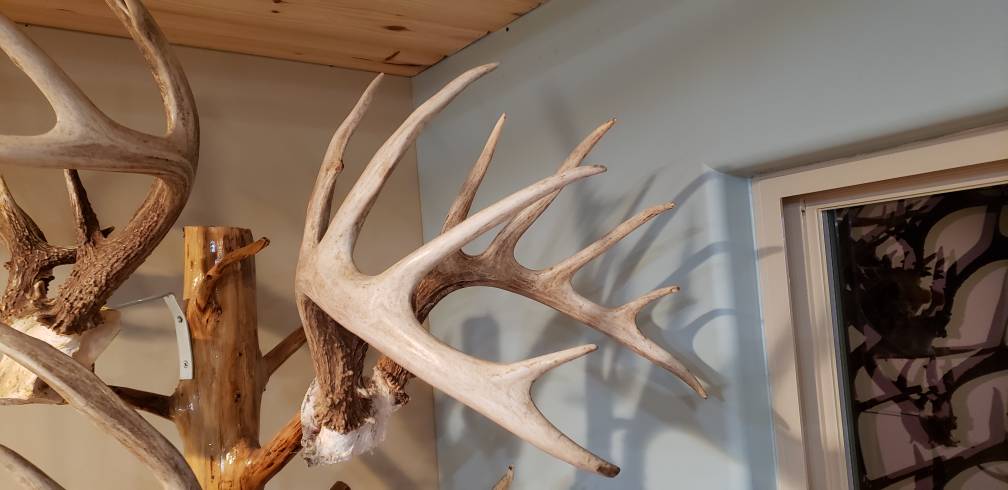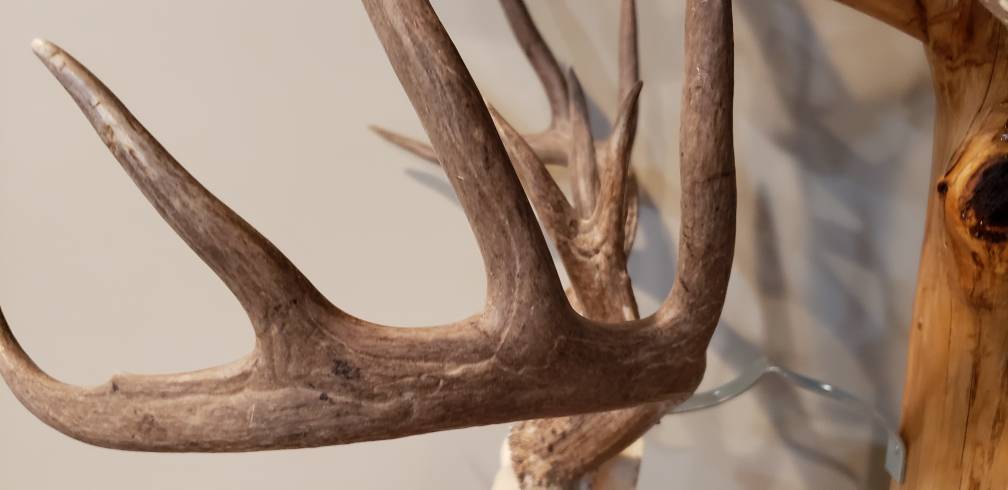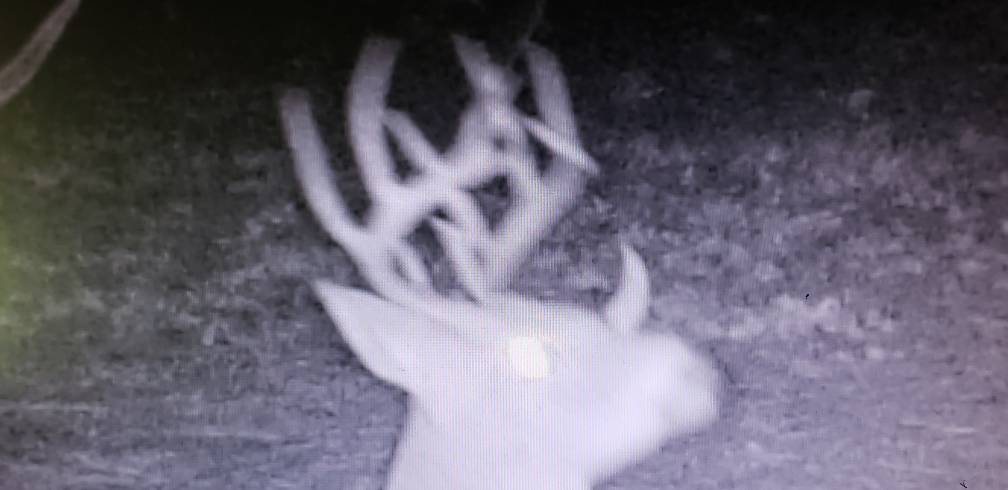-
The forum has been upgraded to support both light and dark themes. Click here for directions.
You are using an out of date browser. It may not display this or other websites correctly.
You should upgrade or use an alternative browser.
You should upgrade or use an alternative browser.
Antler Conformation
- Thread starter Bowriter
- Start date
catscratch
Well-Known Member
Shot from the same property. Very different colorations! I actually prefer the darker phase of antler but it seems to be an anomaly here. Humidity related?


Sent from my SM-N960U using Tapatalk


Sent from my SM-N960U using Tapatalk
dogghr
Well-Known Member
Speaking of rails, and I'm being serious, I am no longer using tree tubes. The deer and coons and wasps are a PIA with them. Even tho they take more time, my cages have been much more effective and I don't have issues with the above. I guess they have their place but I''ll need to cage all my Silkys and hazelnuts this year removing tubes so they can finally grow tall.
And a plus is my narrow racked, thick understory trapped, under 140 class bucks ,can at least browse thru the cage and hopefully get some nourishment to survive.
And Drew of course is one heck of a player Baker.
And a plus is my narrow racked, thick understory trapped, under 140 class bucks ,can at least browse thru the cage and hopefully get some nourishment to survive.
And Drew of course is one heck of a player Baker.
Hoosierhunting
Well-Known Member
Don't worry Okie - I will get this thread back on track:

Holy &$@% what environmental conditions lead to unicorns? Does he fart rainbows, or is that another subspecies?
Sent from my iPhone using Deer Hunter Forum
Hoosierhunting
Well-Known Member
Holy &$@% what environmental conditions lead to unicorns? Does he fart rainbows, or is that another subspecies?
Sent from my iPhone using Deer Hunter Forum
Please answer in riddle form only.
Sent from my iPhone using Deer Hunter Forum
catscratch
Well-Known Member
Drycreek
Well-Known Member
Holy &$@% what environmental conditions lead to unicorns? Does he fart rainbows, or is that another subspecies?
Sent from my iPhone using Deer Hunter Forum
Easy answer, that deer came from woods that are all but impenetrable for the averaged racked buck, and even then he had to crawl on his knees. Native, got any pics of his calloused knees ?
Native Hunter
Well-Known Member
Holy &$@% what environmental conditions lead to unicorns? Does he fart rainbows, or is that another subspecies?
Sent from my iPhone using Deer Hunter Forum
To add to this mystery, I only got pictures of this deer on one camera on one day. Never showed up again. I did smell something like skittles when I checked the camera....
catscratch
Well-Known Member
Calloused knees? Are you talking deer or Kwood's tall... skinny... um... well?
Sent from my SM-N960U using Tapatalk
Sent from my SM-N960U using Tapatalk
Native Hunter
Well-Known Member
Easy answer, that deer came from woods that are all but impenetrable for the averaged racked buck, and even then he had to crawl on his knees. Native, got any pics of his calloused knees ?
Sorry...I would like to say I did, but just like Ole Abe Lincoln - I cannot tell a lie...
catscratch
Well-Known Member
Wide and unicorn at the same time?

Sent from my SM-N960U using Tapatalk

Sent from my SM-N960U using Tapatalk
I don't have any unicorns pics but thought I would post this one for chuckles. One relatively narrow buck with one extraordinarily wide buck in same frame. The front one was 18 1/2" i.s best I remember at 188" . I rattled him up for a buddy. Quite exciting. The one in back I think is over 30" i.s.What does this say about width being an adaptation to environment? Maybe just an anomaly? Naw! { apologies for photo quality I took pic off video }


Uhhh neither of those is what I call narrow. Narrow to me is under 16-17". Neither of those bucks would have made it past 3.5 around here and if they did, it is quite doubtful either would be near that wide, or high or heavy. Our state record, if I remember correctly, is 184". I have seen many mature bucks with 8-12 points that did not measure over 16". I have also many mature bucks with 8-12 points with over 20" of spread. But not in the same area. However, you can travel less than 75-miles from here and find bucks that routinely measure over 20"-spread and one that measured 28.
Uhhh neither of those is what I call narrow. Narrow to me is under 16-17". Neither of those bucks would have made it past 3.5 around here and if they did, it is quite doubtful either would be near that wide, or high or heavy. Our state record, if I remember correctly, is 184". I have seen many mature bucks with 8-12 points that did not measure over 16". I have also many mature bucks with 8-12 points with over 20" of spread. But not in the same area. However, you can travel less than 75-miles from here and find bucks that routinely measure over 20"-spread and one that measured 28.
Wouldn't you agree that what is wide or narrow to man [ you ] is irrelevant in genetic adaptation to habitat. I doubt 1 or 2 inches is meaningful . If bucks are getting shot at 3 or younger who knows what their genetic potential is for width or anything else. They are still babies. The point of the photo was to show completely different genetic variations that are probably 12" different in width both living in the same habitat. That they are mature shows them expressing most if not all their genetic potential .
Baker-I think you are missing the point. What I was pointing out is simply, you cannot compare animals from one area with animals from another, regardless of age. The fact you have two bucks, in your terms, one wide and one narrow, is quite common regardless of the definition of wide and narrow. But compare "wide" only between, say, Alabama or Louisiana and Texas or Oklahoma or IA. Which provides the largest percentage of "wide" spreads in mature bucks? You will find very few 6.5-yr. old bucks killed here that exceed 20" in spread. The norm is more like 17 or 18. That is "Wide, here. In say Alabama, it is even less. That same oddity can be seen various parts of Texas. Compare hill country deer with South Texas deer and plains deer. BUT...in any population, annomalies exist. One such is a deer killed in KY in 1964-it had an inside spread 30-2/8. Yet, it measures a total of two inches smaller that one with an 18-7/8"-inside spread. Two deer from the same general area, but totally opposite in antler configuration-as in the two you showed. Not at all unusual. But in that same area of KY, the average inside spread of the top six or eight bucks taken was about 23-inches. (My records are old-probably been upped some since then due to supplemental feeding and reduction of buck limits.)
Native Hunter
Well-Known Member
You never like Baker's
Baker, he never likes any of your examples - apparently because you don't cooperate. Maybe he will like mine better. These two deer ran together the whole summer. First a pic of them together and next a pic of each facing the camera.



Wouldn't you agree that what is wide or narrow to man [ you ] is irrelevant in genetic adaptation to habitat. I doubt 1 or 2 inches is meaningful . If bucks are getting shot at 3 or younger who knows what their genetic potential is for width or anything else. They are still babies. The point of the photo was to show completely different genetic variations that are probably 12" different in width both living in the same habitat. That they are mature shows them expressing most if not all their genetic potential .
Baker, he never likes any of your examples - apparently because you don't cooperate. Maybe he will like mine better. These two deer ran together the whole summer. First a pic of them together and next a pic of each facing the camera.



Baker-I think you are missing the point. What I was pointing out is simply, you cannot compare animals from one area with animals from another, regardless of age. The fact you have two bucks, in your terms, one wide and one narrow, is quite common regardless of the definition of wide and narrow. But compare "wide" only between, say, Alabama or Louisiana and Texas or Oklahoma or IA. Which provides the largest percentage of "wide" spreads in mature bucks? You will find very few 6.5-yr. old bucks killed here that exceed 20" in spread. The norm is more like 17 or 18. That is "Wide, here. In say Alabama, it is even less. That same oddity can be seen various parts of Texas. Compare hill country deer with South Texas deer and plains deer. BUT...in any population, annomalies exist. One such is a deer killed in KY in 1964-it had an inside spread 30-2/8. Yet, it measures a total of two inches smaller that one with an 18-7/8"-inside spread. Two deer from the same general area, but totally opposite in antler configuration-as in the two you showed. Not at all unusual. But in that same area of KY, the average inside spread of the top six or eight bucks taken was about 23-inches. (My records are old-probably been upped some since then due to supplemental feeding and reduction of buck limits.)
No I don't think I'm missing the point at all. I do not believe antler width is a genetic adaptation to habitat. You said antler width is a genetic adaptation to habitat and I disagree . I show specific examples and you divert. Just as you did when I asked you to speak specifically to what state and county you had such abysmal results with your mgt. plan.
Pardon me for being cranky but I just saw the Saints get screwed out of a trip to the super bowl.
Similar threads
- Replies
- 18
- Views
- 4K
